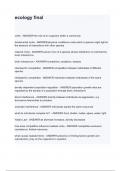Chemistry Study Notes
Rea’s Notes
Grade 12 Final
2016
3 Hour Exam
200 Marks
Table of Contents
Quantitative Chemistry -------------------------------------------------------------------------------------------------------- 1
Chemical Bonding -------------------------------------------------------------------------------------------------------------- 6
Energy Change & Rates of Reactions -------------------------------------------------------------------------------------- 12
Chemical Equilibrium -------------------------------------------------------------------------------------------------------- 16
Acids & Bases ----------------------------------------------------------------------------------------------------------------- 19
Electrochemistry --------------------------------------------------------------------------------------------------------------- 23
Organic Chemistry ------------------------------------------------------------------------------------------------------------ 31
PREFIXES COMMONLY USED FOR UNITS ------------------------------------------------------------------------- 42
from IEB document
italics = learn by heart
(*) definition formula
not on formula sheet
,Quantitative Chemistry
Balanced Chemical Equations
Polyatomic ions
Negative ions (anions)
-
OH hydroxide SO42- sulphate
NO3- nitrate SO32- sulphite
NO2- nitrite S2O32- thiosulphate
MnO4- permanganate O22- peroxide
CℓO3- chlorate MnO42- manganate
HCO3- hydrogen carbonate (ion) CrO42- chromate
HSO4- hydrogen sulphate Cr2O72- dichromate
HSO3- hydrogen sulphite CO32- carbonate
CH3COO- acetate / ethanoate PO43- phosphate
Positive ions (cations)
+
NH4 ammonium Ag+ silver
H3 O+ hydronium / oxonium Zn2+ zinc (II)
The Periodic Table
meaning:
• element is sodium
• 23 protons & neutrons in nucleus
• nucleons
• 11 protons & 11 electrons
• neutrons: 23 - 11 = 12
• sodium is 11 on the periodic table
• atomic number (23) = number of protons and number of electrons
• atomic mass (11) = number of protons + number of neutrons
• electronegativity is 2,1
No. Name Sym. No. Name Sym.
1 hydrogen H 22 titanium Ti
2 helium He 24 chromium Cr Diatomic elements
3 lithium Li 25 manganese Mn
Magnetic elements
4 beryllium Be 26 iron Fe
5 boron B 27 cobalt Co
6 carbon C 28 nickel Ni
7 nitrogen N 29 copper Cu
8 oxygen O 30 zinc Zn
9 fluorine F 33 arsenic As
10 neon Ne 35 bromine Br
11 sodium Na 47 silver Ag
12 magnesium Mg 50 tin Sn
13 aluminium Al 53 iodine I
14 silicon Si 54 xenon Xe
15 phosphorus P 74 tungsten W
16 sulphur S 78 platinum Pt
17 chlorine Cl 79 gold Au
18 argon Ar 80 mercury Hg
19 potassium K 82 lead Pb
20 calcium Ca 87 francium Fr
92 uranium U
Rea’s Notes | Page 1
,Writing Balanced Chemical Equations
reactants products solid phase
s
crystal lattice
solute
substance which is dissolved
state
precipitate is solid
gaseous phase
↓
g
aqueous
↑
aq
liquid phase
dissolves in solute
ℓ
usually water
solvent
does not partake in reaction
substance in which another
concentrated acid
substance is dissolved
c
Interpret balanced reaction equations in terms of
conservation of atoms
The conservation of atoms in chemical reactions leads to the principle of conservation of matter
and the ability to calculate the mass of products and reactants.
conservation of mass (use relative atomic masses)
during chemical reaction / physical change,
sum of masses of reactants = the sum of masses of products
The Mole Concept
mole SI unit for amount of substance
quantity of matter that has same number of particles (atoms, molecules
mole or ions) as there are atoms in 12 grams of carbon-12
quantity of matter that contains Avogadro’s number of formula units
molar mass (*) mass in grams of one mole of that substance
1 mole contains Avogadro's number of particles ( )
n number of moles mol moles
m mass g grams
-1
M molar mass g.mol grams per mole
Molar Volume of Gases
Avogadro’s Law equal volumes of all gases (@ STP) contain same number of units (atoms/molecules)
n number of moles mol moles
3
V volume of gas dm decimetres cubed
3 -1
Vm molar gas volume @ STP 22,4 dm .mol dm3 per mole
* STP = standard temperature and pressure
get molar mass from periodic table
molar mass of diatomic elements = 2x mass of element
1000cm3 = 1 dm3 = 1ℓ
1 mole of gas occupies 22,4 dm3 at 0°C (273 K) and at 1 atmosphere (101,3 kPa)
Rea’s Notes | Page 2
, Volume relationships in gaseous reactions
Explosions
ammonium nitrate (NH4NO3) used for making explosives
e.g. dynamite Not in IEB doc:
the huge volume of gas suddenly produced causes explosion Volume
all products of reaction are gases, none are dangerous relationships in
2NH4NO3(s) 2N2(g) + 4H2O(g) + O2(g) gaseous reactions
Combustion in car’s engine
spark plug in car’s engine ignites fuel (C8H18) which reacts with oxygen to produce CO2 gas + water vapour
volume of gas produced
large enough to cause pressure build up to push piston down again
provides needed power to move engine + car
2C8H18(l) + 25O2(g) 16CO2(g) + 18H2O(g)
Airbags
inflation of airbag involves chemical reaction that produces large volume of gas which inflates bag
sensors at front of car send electric signal to canister containing sodium azide (NaN 3)
sodium azide then detonated
ignites + starts decomposition reaction producing gas
occurs in 0,03 seconds
2NaN3(s) 2Na(s) + 3N2(g)
Concentration of Solutions
solute substance that is dissolved in solution
solvent substance in which another substance is dissolved, forming solution
number of moles of solute per unit volume of solution
concentration (*)
gives idea of strength of solution
standard solution solution of known concentration
technique where solution of known concentration is used to find info about
titration
solution that it is being reacted with
reaction in which 2 separate solutions are mixed together to form insoluble
precipitation reaction
compound that settles at bottom as solid
precipitate insoluble compound formed during precipitation reaction
chemical that determines how far reaction will go before chemical in question gets
limiting reagent
used up, causing reaction to stop
substance in excess reactant that is left over at end of reaction, once limiting reagent has been used up
c concentration mol.dm-3 moles per dm3
n number of moles mol moles
3
V volume dm decimetres cubed
n number of moles mol moles
N number of particles
NA Avogadro’s number
1 mole contains Avogadro’s number of particles
never changes
weak acid/base
strong acid/base
can change, may add water
dilute acid/base
concentrated acid/base
Rea’s Notes | Page 3











